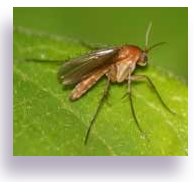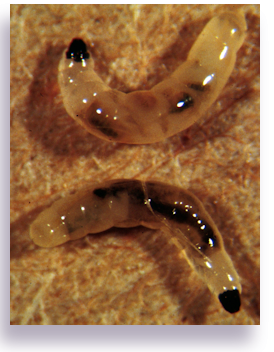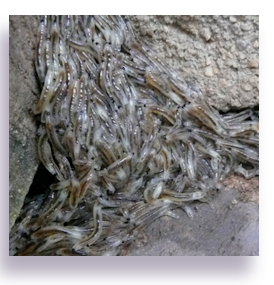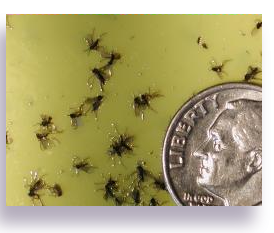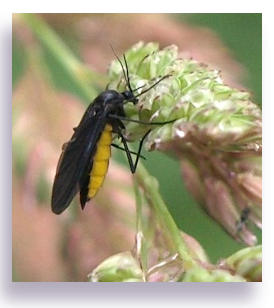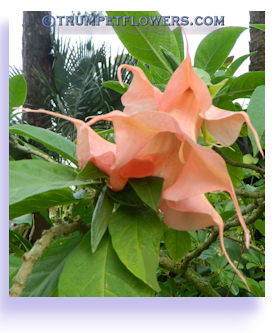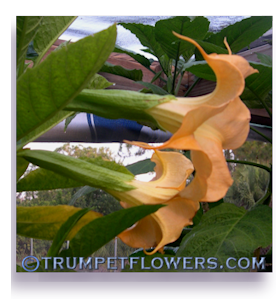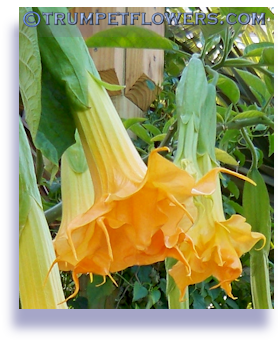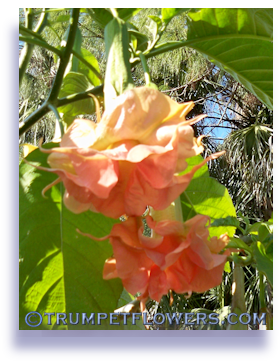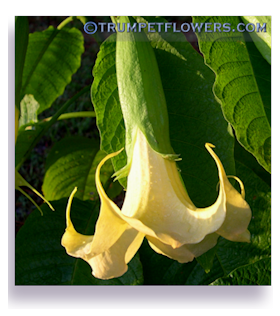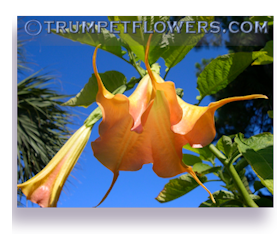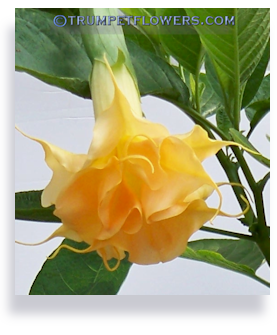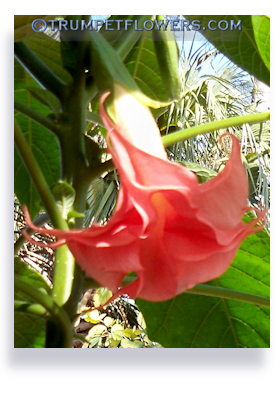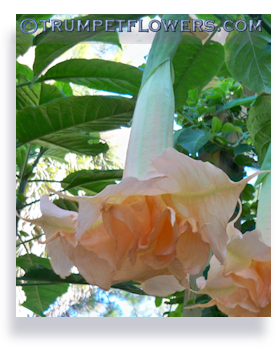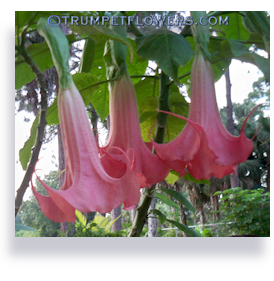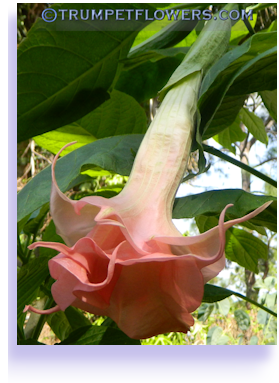Insect Pest
Elimination
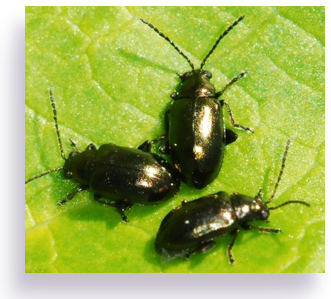 Insect pests in the garden are more than annoying, they spell trouble for all the progress you've been trying to make. Many of the pests I name here bother our beloved Brugmansia, others, like flea beetles, never seem to bother them. Many are discernable, and can be hand picked. Others are small, almost unseeable, and you don't even know they are there until the mark of decimation is apparent. The photo to left show Flea beetles. Flea beetles are tiny, hard shelled beetles that hop from plant to plant, sucking on them. You can tell they have been there when you see tiny pin holes in the leaves. Spray Pyrethrums to kill them.
Insect pests in the garden are more than annoying, they spell trouble for all the progress you've been trying to make. Many of the pests I name here bother our beloved Brugmansia, others, like flea beetles, never seem to bother them. Many are discernable, and can be hand picked. Others are small, almost unseeable, and you don't even know they are there until the mark of decimation is apparent. The photo to left show Flea beetles. Flea beetles are tiny, hard shelled beetles that hop from plant to plant, sucking on them. You can tell they have been there when you see tiny pin holes in the leaves. Spray Pyrethrums to kill them.
Organic pest control is best if you can go this route. If not, and you need to go stronger, read on gardening friends.
Some garden pest insects will not succumb to organic methods. Among them are spidermites and broad mites. They seem to appear just at the end of spring here in SW Florida, so I am ready for them with chemicals. For these pests, there are two poisons available that will work. Neither one can be used on food crops. If you have tomatoes or melons, as an example, better go with organic methods (pick off all affected leaves) of control if spidermites are a problem for you.
Avid and Forbid are used by the commercial plant growing industry to wipe out spidermites on non∼food plants, such as brugmansia. And they actually work. Avid, which is actually abamectin, must be applied to the entire leaf, top and especially underneath, to kill them. It has to be repeated in 3 days, in order to kill hatchlings, whose eggshell is resistant to the poison.
Forbid is stronger, and only one application is necessary. It does not have to cover every single area of the leaf surface to do the job. It also only has to be applied just once, and lasts the entire season.
Both of these insecticides are applied as foliar sprays. You will need to make sure that the leaves are already dry, and the temperatures outside are not over 80°. Check weather forecasts prior to application, and be sure you have no rains due for about 3 days, so as not to waste your money and effort.
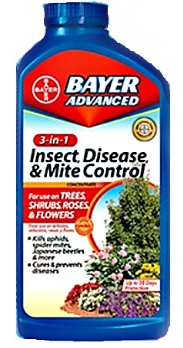 I have noticed that after application, the brugmansia at least; perk up and look much healthier, within just a few days. All that sucking on the life juices of the plants inflicted by the spidermites is gone, and the brugs then thrive. It is very worthwhile to use Forbid on prized brugmansia and other non∼edible garden flowering plants, in my opinion.
I have noticed that after application, the brugmansia at least; perk up and look much healthier, within just a few days. All that sucking on the life juices of the plants inflicted by the spidermites is gone, and the brugs then thrive. It is very worthwhile to use Forbid on prized brugmansia and other non∼edible garden flowering plants, in my opinion.
Just this spring, I started using the over the counter Bayer Insect Disease and Mite Control spray for spidermites. It is concentrated, and for my size collection, three or four bottles should last the whole season. I used it on all the brugmansia, and it has seemed to stop them from their annual spring infestation party. One cultivar had them already, and after applying they are gone within 3 days. I bought it at Lowes for about 18 dollars. If you do not have access to the more pricier chemicals, you may want to try this. The only drawback is that it will need to be reapplied in 7 to 14 days, and again after 30 days. But if it kills the spidermites, I'm happy, and so are my brugmanisa.
The Bayer Insect, Disease and Mite Control also kills tons of other insects. For the sake of my readers, here is the complete list from the actual bottle, whereas it says it will control them. Through my own use, I can attest to the fact I no longer see any of the ones listed that I had a problem with before, including the dreaded fungus gnats! I put an asterick next to pests I have previously seen aggravate brugmansia.
Bayer Insect, Disease and Mite Control List of Insects it Controls or Kills
- adelgids
- *aphids
- armyworms
- bagworms
- beetles
- boxelder bugs
- *budworms
- cankerworms
- *caterpillars
- *chinch bugs
- clover mites
- crickets
- *cucumber beetles
- *cutworms
- *earwigs
- elm leaf beetles
- firebrats
- flea beetles
- *fungus gnats
- *glassy winged sharpshooter
- grasshopper
- gypsy moth larvae
- japanese beetles (adult)
- *lace bugs
- leaf-feeding beetles
- *leaf-feeding caterpillars
- *leaf hoppers
- leafminers, including birch & holly leafminers
- *loopers
- *mealybugs
- midges
- *mites
- pillbugs
- plantbugs
- psyllids
- rose midges
- *rose slugs
- sawflies
- *scale insects (crawler stages)
- *silverfish
- sowbugs
- *spidermites
- spittlebugs
- *stink bugs
- *thrips
- *two-spotted mites
- viburnum leaf beetle
- *webworms
- *weevils (including in underground worm stage & adults)
- *whiteflies

It also controls some fungal diseases. For that list, click Here.
Lastly on spidermites. If you are overwhelmed with them, and about to pull your hair out, pull all of the leaves on your brugmansia instead. Take every last one off, and throw in the burn pile, downwind and away from your brugmansia. Then hose down the entire trunk and stems, wetting them thoroughly, and blasting any pest remaining into space. In just a few short weeks, your brugmansia will have regrown nice big healthy leaves free of spidermites. Make sure to pick up all fallen leaves and keep the area clear of any organic debris to hold them at bay. Do not accidentally nip off the growing tips of any part of the brugmansia plant above the Y. Just get the leaves. If you pinch the growing tips, you will stunt and alter the growth of the brugmansia.
Ants in general do not seem to harm brugmansia, but they indirectly cause damage if the ant colony begins tending to aphids. Just as we herd and tend to cattle, ants care for aphids, carrying them up to the tendermost leaves of your beloved plants, and allowing them to suck the life juice right out of newly forming buds and leaves. In return for their care and protection, the aphids exchange a dewy, sweet syrup juice to the ants, who stroke it from a special gland in each aphid. Bottom line, check new growth for aphids, if you have them, you most likely have an ant situation that needs controlled too.
If you want to get rid of ants on ornamentals, even potted ones, use the below information on fire ants. If it's only the aphids, scroll further down the page.
Fire ants are a huge problem in warmer climates. These formidable tiny monsters wallop a big punch when it comes to biting and venomizing you. I read somehwere that the venom is the same as rattlesnake, just in a much smaller doseage. That would explain the intense pain, swelling, and fluid filled blistering of the area they get you.
Through the years, I have tried many varied tactics on them. Last fall, I hit on one that actually works, with no return for the entire spring, summer and fall of that year. It is a two∼part plan, and if you follow through, I do believe your success will be eminate.
Planning ahead, I begin three days in advance of their total demise; to flood their nest holes with water from the gardening hose. I do this everytime I go by the nests, even if it is 3 or 4 times a day. I had one nest so bad in a small garden last year, I just pulled up one of the chairs and sat there, flooding it, for over 10 minutes.
Repeat this every day for 3 days. What this does is force the worker ants to constantly rebuild the tunnels and entrances, thus having little or no amount of available time to hunt down food sources. The colony will begin to suffer, and begin to eat what is stored in their pantries.
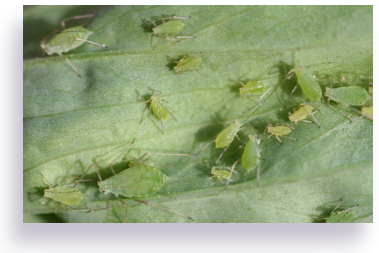 On the fourth morning, feed them a healthy dose of Amdro poison food (bait) granules. Do not dump it right on the newly built nest entrances, but right next to them. Within a moment, they will be all over this newly found food source, hauling it in as fast as they can. They are making up for the last 3 days of lost reserves and hunger, and it will be gone within 10 minutes or so. After this, you should no longer see this colony. Starving them and then feeding them Amdro food granules, forces the ants to completely take in the food and feed it to everyone in the colony, and of course, the queens and even soon to be queens.
On the fourth morning, feed them a healthy dose of Amdro poison food (bait) granules. Do not dump it right on the newly built nest entrances, but right next to them. Within a moment, they will be all over this newly found food source, hauling it in as fast as they can. They are making up for the last 3 days of lost reserves and hunger, and it will be gone within 10 minutes or so. After this, you should no longer see this colony. Starving them and then feeding them Amdro food granules, forces the ants to completely take in the food and feed it to everyone in the colony, and of course, the queens and even soon to be queens.
I found that doing it without the 3 day flooding of the colony entances; left enough alive (through no loss of food source) to raise the exsiting pupae, who will be queens. They will designate one of these pupae for their own new queen, thus defeating your efforts.
By the way, I had previously tried the straight poison granules, that kill many different kinds of bugs, and that you soak into the ground. Those did not work near as good for me as the Amdro poison food granules.
And now, finally, there is an organic, natural way to kill fire ants! Thanks to the research of the USDA, University of Florida's Institute of Food and Agricultural Sciences, the introduction of three species of phorid fly, a parasitic insect that uses the fireants as their hosts, has helped to control these killer ants. You can learn more about how they are released, and find out if you can be selected as a participant in the program by visiting Fresh from Florida phorid fly brochure.
Stink bugs have become a great nuisance to my more northern neighbors, although they are not nearly an issue for me down here in South Florida. However, I'm sure it is only a matter of time before they plague us too, as Florida seems to be the bug capitol of the USA. I have some northern friends who grow brugmansia, and they tell me they are a nuisance on their plants. I watched this video a while back, and he proves that soapy water does in fact kill them. So if they become a pest to you, perhaps you should give it a try too. I did skip through his proof of a million toilet flushes, as he shows this first and although he is trying to make a point it is useless to watch it, at least for me. Afterwards though, you do see the stink bug death experiment.
Skipper moths can also become a nusiance to brugmansia. I usually never encounter a true infestation of them, but it is annoying to find small holes chewed through an otherwise lovely Angel trumpet. More about skippers and photos Here.
Mealybugs can also be a problem for brugmansia. Visit this page for help with killing these pests off: Yellow Necklace pod, Mealy bug removal. There is also a photo for help with identification. If you want to kill them chemically, try Bayer Disease and Insect Control.
Whiteflies drive me crazy! These dusty miniscule pests flit from underneath one brugmansia leaf to the next, and really do damage through leaf sucking, draining them, eventually deforming them. They spread a disease named after them, which cause whitish spots and streaking of the leaves. Killing off an infestation is done easier in Britan than in the states I think, as they use sulphur candles to envelope the entire air within a greenhouse to be rid of them. I have looked for many years for these in the states, and cannot find them. So I have used alternative methods.
Insecticidial soaps (organic treatment) give immediate relief, as the soap breaks down their exoskeletons and kills them. The soap contains phosphorous, and is actually good for the plants. You have to hit them with the spray for it to work of course. Use these if you are bringing your brugs in for the winter, and keep treating for a week or so to truly eliminate them.
Whitefly treatment: Systemic Insect Killers like Bayer 2 in 1 does eliminate them. So if you have a whitefly issue, I have noticed that treating them with the Systemic Insect Killers rids me of them, for a couple of months, up to a year, depending upon which treatment you buy. The granules last up to 8 weeks, but of late I've seen a liquid Bayer on the market that kills for one year. Alternatively, (and it is organic,) if one religiously sprays their plants with Neem oil, it also will eliminate them. I use it every other day, in morning hours after the dew has lifted off of the brugmansia leaves. If you cannot stay on top of it, try other methods, because the Neem oil needs to be used frequently to stop them. Organic sprays from the plant family chyrsanthemum work too. Pyrethrum is the killer factor in these. Bayer Disease and Insect Control will also get rid of them.
For in detail information on whiteflies (there are two species) and their lifecycle, try this excellent read: Garden Harvest Supply Blog on Whiteflies For identification, here's a photo of brugmansia leaves with aphid damage: Brugmansia Pests Leaf Damage.
Aphids can also be killed with Neem oil and Pyrethrum based insecticides. Like whiteflies, they suck the life juice out of your angel trumpets. If you need a stronger treatment, try using the chemical based Mospilan. It was created in Japan. Here is more information on it: Mospilan. Read that it is also toxic to fish, bees and other wildlife. Keep Mospilan away from ponds and any flowers that are visited by our beloved honeybees, who are already being threatened.. It also gets rid of thrips, mealbugs, red scale, citrus leafminers and psilla. Bayer Disease and Insect Control kills them too.
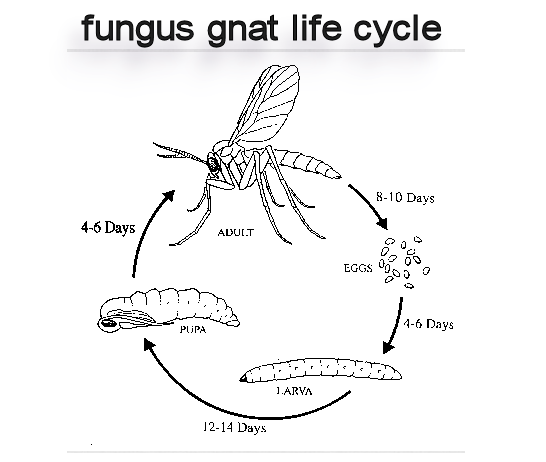
Fungus gnats can be a problem if your soil surface is too moist, or during winters in a greenhouse setting. These horrible miniscule pests turn into tiny worms that eat the tiny feeder roots (and eventually the larger ones) of your prized brugmansia. I especially have to be careful of them when I am rooting up cuttings of brugmansia during the cooler winter months. Using rainwater I collected during rainy season does deter the growth of algae on the pot surfaces which discourages fungus gnat presence.
You can also control them with Diatomaceous Earth or ground cornmeal by spreading a thin coat over the entire surface of the planter the angel trumpet is in. And try to keep the soil surface a bit drier, especially on tender new seedlings and unrooted cuttings. You can also spread a light dusting of regular cornmeal or sharp sand on the surface of the pot.
Here is a surefire method to kill fungus gnat larvae that I recently tried. And it helps the plant at the same time! Use this method on potted plants whose root systems are at least filling a 1 quart pot size.
Allow the potted brugmansia to go without water for a day or so, until the top portion of the soil dries. Although they won't like this, they will survive it. Brugmansia are a tough plant to kill. If needed, place it in a shady spot while it goes through the no water ban.
On the second to third day of no watering, the soil should be dry enough to now kill the fungus gnat larvae. Take a half gallon to gallon jug that is rinsed out and clean, and add 1 cup of regular, over the drugstore counter 3 percent Hydrogen Peroxide to it. Now add 4 cups of clean water to the hydrogen peroxide. Pour enough of the water and peroxide mixture into the soil that it drains out the bottom. It will fizz, and it will instantly kill the soil borne crustaceans, fungus gnats, and any other burrowing insect larvae that were present! It also feeds an abundance of oxygen to the plant's root system. The fizzing will stop, and the plant is now (underground) pest free.
Finally, if you must go chemical, try the Bayer Disease and Insect Control.
For more on fungus gnats and other methods to get rid of them, even when in the stage of their lifecycle where they go underground, read the Garden Questions and Answers, Rootworms section.
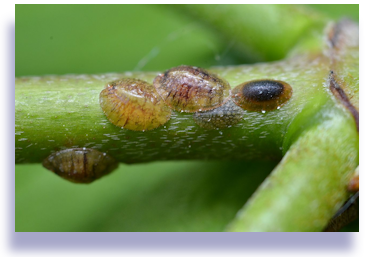 Scales are tiny, roundish hard bumps that appear on tender stems of citrus, rose, hibiscus, and many other flowering plants. I have never seen them on my brugmansia. Related to mealybugs, they can also be controlled with Mospilan, if you want to go with a toxic chemical. But I choose to take the lot of them on by hand, squishing them into oblivion by rubbing hard on the stems until they turn to goo. I wash my hands and the stem off, and check to make sure I have gotten them all. If you find them, look on other areas of the plant and nearby plants too. Spending 15 minutes checking through and rubbing them out will save you aggravation (and save later blooms!) and money, as you didn't do the chemical treatment. For a chemical means of elimination, try the Bayer Insect, Disease and Mite Control listed earlier.
Scales are tiny, roundish hard bumps that appear on tender stems of citrus, rose, hibiscus, and many other flowering plants. I have never seen them on my brugmansia. Related to mealybugs, they can also be controlled with Mospilan, if you want to go with a toxic chemical. But I choose to take the lot of them on by hand, squishing them into oblivion by rubbing hard on the stems until they turn to goo. I wash my hands and the stem off, and check to make sure I have gotten them all. If you find them, look on other areas of the plant and nearby plants too. Spending 15 minutes checking through and rubbing them out will save you aggravation (and save later blooms!) and money, as you didn't do the chemical treatment. For a chemical means of elimination, try the Bayer Insect, Disease and Mite Control listed earlier.
Some other pests and mostly fungal infections can be controlled using Rose 3 in 1 by Bayer. You can read more about it at that link I added.
And, on the Links page, scroll down to the Rosemania paragraph and website link. This online supplier has many insecticidals listed for sale, that will help beautify your garden and your angel trumpets.
NEVER USE ATRAZINE!!! Insecticides containing this are on the edge of being banned in the US, for good reason. There are all sorts of human and environmental problems directly linked to the use of atrazine. It is now being found in drinking water, and this poison has serious effects to children, pregrant women, and the elderly. It kills frogs, birds, fish and other living things. Steer clear of it's use, there are plenty of other insecticides readily available that will do the job.
Here is more on the issue of atrazine and how it is detrimental to the health of the planet: Dr. Kerry Kriger of 'Save the Frogs' and the use of atrazine
For more pests, and beneficial insect information related to brugmansia, read Insects. There you will find a comprehensive list. For bacterial and fungal issues, try Plant Diseases and Fungal issues.
Tags: eliminate insect pests,, pest insect control insects, brugmansia insect pests, hornworms, hawkmoths, caterpillar damage to brugmanisa, insect pests, eliminate insect pests, garden pests,spidermite control, fungus knats, forbid, avid, broad mite control, fire ant control, kill fireants, kill spidermites, pests, brugmansia pests,

